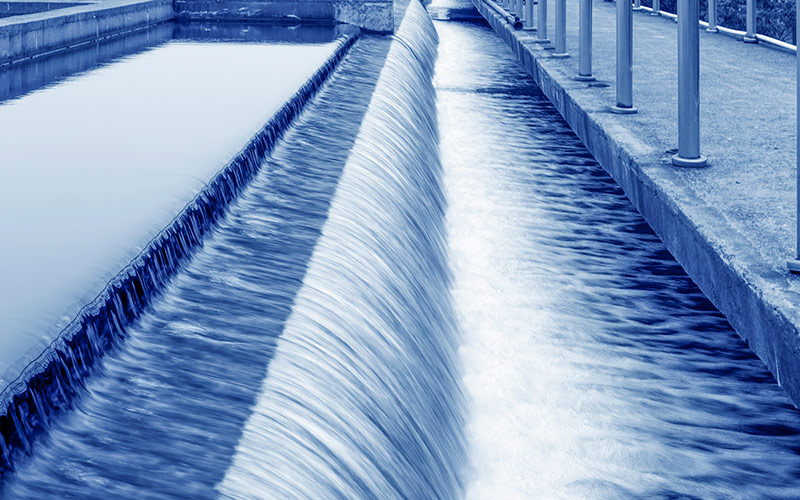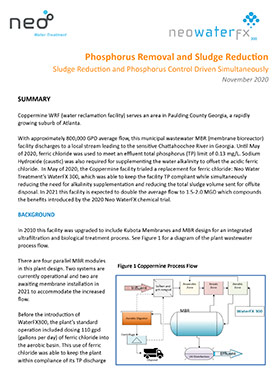Sludge Reduction and Phosphorus Control Driven Simultaneously
November 2020
Summary
Coppermine WRF (water reclamation facility) serves an area in Paulding County Georgia, a rapidly growing suburb of Atlanta.
With approximately 800,000 GPD average flow, this municipal wastewater MBR (membrane bioreactor) facility discharges to a local stream leading to the sensitive Chattahoochee River in Georgia. Until May of 2020, ferric chloride was used to meet an effluent total phosphorus (TP) limit of 0.13 mg/L. Sodium Hydroxide (caustic) was also required for supplementing the water alkalinity to offset the acidic ferric chloride. In May of 2020, the Coppermine facility trialed a replacement for ferric chloride:; Neo Water Treatment’s WaterFX300, which was able to keep the facility TP compliant while simultaneously reducing the need for alkalinity supplementation and reducing the total sludge volume sent for offsite disposal. In 2021 this facility is expected to double the average flow to 1.5-2.0 MGD which compounds the benefits introduced by the 2020 Neo WaterFX chemical trial.
Background
In 2010 this facility was upgraded to include Kubota Membranes and MBR design for an integrated ultrafiltration and biological treatment process. See Figure 1 for a diagram of the plant wastewater process flow.
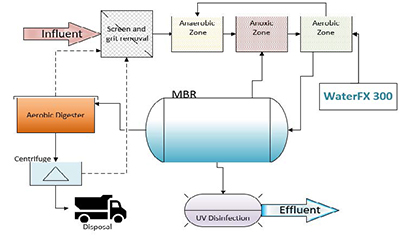
Figure 1 Coppermine Process Flow
There are four parallel MBR modules in this plant design. Two systems are currently operational and two are awaiting membrane installation in 2021 to accommodate the increased flow.
Before the introduction of WaterFX300, the plant’s standard operation included dosing 110 gpd (gallons per day) of ferric chloride into the aerobic basin. This use of ferric chloride was able to keep the plant within compliance of its TP discharge permit limit of 0.13 mg/L. However, with the high dosage of ferric chloride, the plant needed to supplement the alkalinity with caustic at a dose of 112 gpd into the aeration basin to provide alkalinity for the biological nitrogen removal process, and to maintain the alkalinity and pH within the limits of its permit for effluent discharge.
The plant made the decision to proceed with a trial of WaterFX300 in order to maintain a low TP limit with much less coagulant volume, minimize demand for caustic, and greatly reduce the volume of sludge generated.
Trial Overview
Chemical P Removal
WaterFX300 was dosed directly into the aerobic zone prior to the MBR beginning May 20th, 2020, and the use of ferric chloride was suspended at the same time.
During the months of May through October, plant operators made several adjustments as they learned how to balance the WaterFX300 feed to match the incoming flow and TP of the plant and keep the effluent safely under the effluent limit. This was accomplished quickly as the feed of WaterFX300 required only a few ml/min adjustment each day or every few days.
| Parameter (at 0.8 MGD) | Pre-May 2020 | Post-May 2020 |
| Ferric Chloride 38% (gpd) | 110 | 0 |
| Caustic 20% (gpd) | 112 | 0 |
| WaterFX300 (gpd) | 0 | 21-26 |
Control over the effluent TP was achieved quickly, and the feed of caustic was quickly scaled down and/or turned off within a few days. As shown in the figure below, when the facility switched back to ferric for most of September and October to clean out the ferric tanks, the TP trended back up. However, when it switched back to the WaterFX300 in late October, the effluent TP trend reversed back down again.
Figure 2 Effluent TP throughout 2020 with WaterFX300 and Ferric Chloride
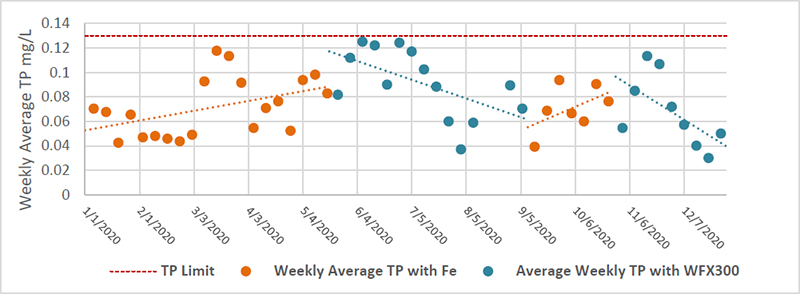
As shown in Figure 2 above, the effluent TP tested by the Coppermine facility and submitted to the Georgia EPD, remained consistently below the TP limit throughout 2020. The key difference is that the WaterFX300 dose was approximately 4-5 times less than the ferric chloride dose.
Ferric chloride typically has a pH under 2, making it corrosive and hazardously acidic. To meet TP limits, facilities often must use such high volumes of ferric chloride to reduce system pH and consume system alkalinity. Facilities like Coppermine must add caustic (sodium or magnesium hydroxide) to the system to balance the pH and to provide alkalinity for nitrogen removal to cancel the effects of ferric chloride. In this case, 112 gallons of 20% sodium hydroxide per day were added to offset 110 gallons per day of ferric.
By comparison, WaterFX300 is non-hazardous, and, at a pH of 3-4, is around 100 times less acidic. Combined with the 5x reduction in volume needed to meet TP requirements at Coppermine, WaterFX300 presents an option that introduces around 500x less acid to the water treatment system. Due to this reduction in acidic chemical addition, Coppermine was able to eliminate the supplemental caustic.
Soon after the trial began, 21-26 gallons per day of WaterFX300 replaced all 110 gallons of ferric chloride and 112 gallons of caustic. Focusing on just the cost of these three chemicals, the WaterFX solution is expected to save Coppermine $23,400 per year.
Sludge Reduction
Once the chemical system at Coppermine settled into a daily routine and effluent TP was securely under control and stable, the focus of observation shifted to the decrease in sludge volume. Chemical coagulants like ferric chloride, and aluminum sulfate, (and WaterFX300 to be fair) will generate approximately 0.5 lbs. of dry chemical sludge per solution pound of chemical added. When sludge is dewatered to 20% solids, this 0.5 lbs. of dry sludge expands to 2.5 lbs. of wet chemical sludge per pound of chemical used. A facility like Coppermine, using 110 gallons per day of ferric chloride, could be making around 3,000 lbs. per day of additional wet sludge just from adding the ferric chloride. Thus, it pays for the ferric twice — , once to purchase it and again to dispose of the waste it generates. WaterFX300 reduces this sludge simply by requiring less chemical to accomplish the same result.
In addition to WaterFX300 generating less chemical sludge, Coppermine found the benefit of enhanced dewatering after switching from ferric chloride. While using ferric chloride at 110 gallons per day in the weeks before the trial, the centrifuge cake typically returned around 25-28% solids by weight. After switching to WaterFX300, the centrifuge returned a dryer cake, at around 28-35% solids as shown in figure 3 below.
Figure 3 Percent Solids In 2020, WaterFX300 vs Ferric Chloride
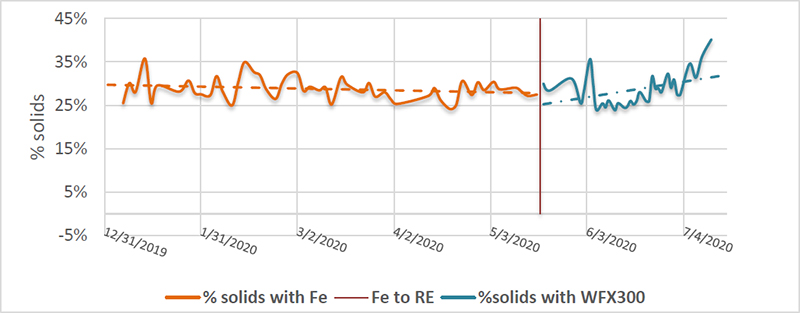
The combination of generating less chemical sludge and dewatering to a higher % solids in the centrifuge directly resulted in fewer truckloads sent to disposal. While using ferric chloride, the facility wasted and dewatered 5 days per week, (sending 1 full container of sludge to disposal each day of dewatering. ), but after switching coagulants to WaterFX300, the plant reduced the wasting/dewatering and roll-offs sent to disposal to just 3 or 4 days/roll-offs per week. Coppermine’s cost of a sludge roll-off is $1800, which includes hauling, tipping fees, and disposal off site. The sludge volume decrease is due to the increase in % cake solids and to the complete removal of thousands of pounds of chemical sludge from ferric. To put this into perspective, the reduction in sludge at this facility from the use of WaterFX300 results in a disposal savings of around $150,000-$200,000 per year with additional savings of around $3,000 in polymer (also related to the sludge reduction).
Highlights while using WaterFX300
- TP was kept in control with 21-26 gpd of WaterFX300 vs 110gpd of ferric
- The need for caustic addition was eliminated
- Centrifuge cake solids increased from about 25-28% to 28-35%
- The polymer use was reduced by 33% in the centrifuge
- The operation of the centrifuge was reduced by 1-2 days per week
- Total sludge was reduced by about 20-40% based upon roll-offs sent for disposal
Additional Benefits Observed
The membranes were cleaned in October 2020 with sodium hypochlorite and the permeate levels were restored to almost factory permeability performance. This is significant because previous cleanings required oxalic acid to restore the membranes’ permeability due to the heavy fouling caused by ferric chloride. The facility would prefer not to use oxalic acid due to its serious safety and handling issues.
After the switch to WaterFX300, the facility eliminated the oxalic acid cleanings and can now clean and restore the membranes to good operating condition using a much safer solution of commercial sodium hypochlorite.
Results And Conclusion
There were many operational and monetary benefits from this trial at Coppermine:
- The TP results were maintained at or below the Georgia EPD permit limit throughout the trial period while using WaterFX300
- The chemical savings of changing to WaterFX300 from the previous ferric chloride coagulant and caustic, saved the plant an additional $23,400/year
- The centrifuge cake solids increased from 25% to greater than 28% during the trial period
- WaterFX300 dramatically reduced the volume of sludge from the facility – disposal volume decreased from 5 roll-offs per week with Ferric Chloride to 3-4 roll-offs per week with WaterFX300. This represents a significant operational savings during the trial of approx. $3600/week or nearly $200,000/year.
- During the entire trial period there were no reported instances of non-compliance to the Georgia EPD and, since that time, the plant has been in total compliance with its National Pollutant Discharge Elimination System (NPDES) discharge permit.
- The Coppermine WRF facility is convinced that the WaterFX300 trial was a success and is continuing to use the WaterFX300 as their coagulant. In 2021 Coppermine will be continuing to optimize their process and prepare for a 100% expansion of their membrane plant to accommodate the increased influent flow expected in the coming year.
Phosphorus Removal From Wastewater
Learn more about Phosphorus Removal From Wastewater.

